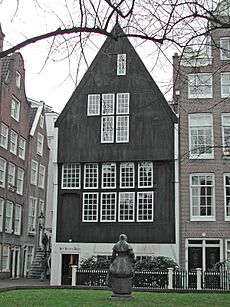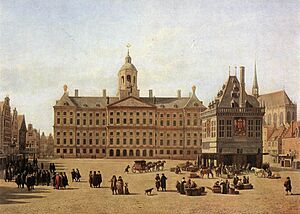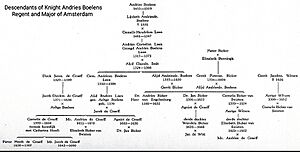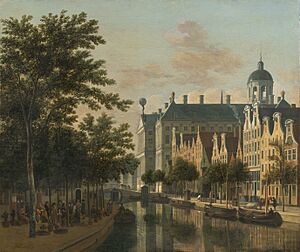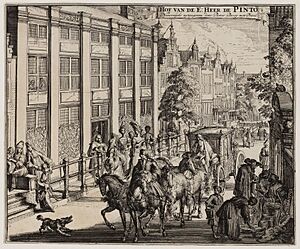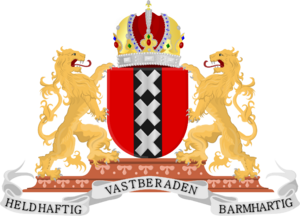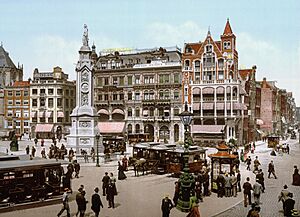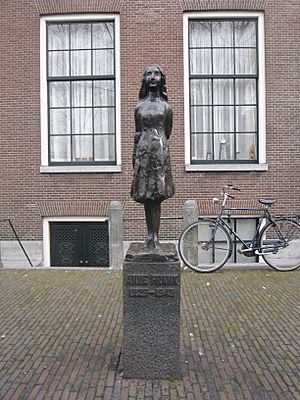History of Amsterdam facts for kids
Amsterdam has a long and exciting history! It started in the 12th century when fishermen built a bridge over the Amstel River, near a large saltwater area called the IJ. Wooden barriers under the bridge acted like a dam, protecting the village from floods. The mouth of the Amstel River became a natural harbor, perfect for trading. Big ships could transfer goods to smaller ones that traveled further inland.
The first time "Aemstelredamme" (Amsterdam) was mentioned in writing was on October 27, 1275. In this document, Count Floris V of Holland said that people from the village didn't have to pay tolls (fees) to cross bridges in his county.
Even older discoveries were made between 2005 and 2012 during metro construction. Archaeologists found ancient tools and pottery about 30 meters underground. These items date back to the New Stone Age, around 2600 BCE! This means people lived in the Amsterdam area much earlier than thought.
Contents
Early History and City Rights
In 1204, a castle near the Amstel dike was destroyed. This event was later used in a famous Dutch play called "Gijsbrecht van Aemstel."
A very important year for Amsterdam was 1275. Even though the Amstel area was ruled by the Bishop of Utrecht, Count Floris V of Holland gave traders, sailors, and fishermen freedom from tolls. This "Gift Letter" is the oldest document using the name "Aemstelredamme." It meant people from Amsterdam could travel through Holland without paying fees at bridges or dams. This helped the young city become rich! Traders could sell their goods (from places like Scandinavia, Germany) at better prices. By 1327, the city's name had become "Aemsterdam."
In 1306, Amsterdam officially received city rights from the Bishop of Utrecht. After he died, Amsterdam became part of the County of Holland.
In 1323, a toll was placed on beer traded from Hamburg. This beer trade helped Amsterdam connect with cities of the Hanseatic League in the Baltic Sea. From these cities, Amsterdam got grain and timber, which were very important for its growth. In 1342, the city received the "Groot Privilege," which made it even stronger. By the 15th century, Amsterdam was the main trading city in Holland and supplied grain to the northern low countries.
According to a story, a miracle happened in Amsterdam on March 12, 1345. Because of this, Amsterdam became an important place for religious journeys. The city grew a lot thanks to these visitors. Even today, a Catholic procession happens every year to remember the miracle.
Two big fires hit the city in 1421 and 1452. The second fire destroyed three-quarters of Amsterdam! After that, the ruler ordered that new houses had to be built from stone. Very few wooden buildings from that time still exist, like "Het Houten Huys" (The Wooden House) in the Begijnhof.
Religious Changes and the Dutch Revolt
In the early 1500s, a new religious movement called the Protestant Reformation began. A group called the Mennonites became strong in Amsterdam. Religious tensions grew, and the ruler, Emperor Charles V, ordered that Mennonites be persecuted. Many were punished or forced to leave.
The second half of the 16th century brought a big rebellion in the Low Countries against the Spanish king, Philip II. This fight was mainly about local leaders wanting more power and the conflict between Protestants and Catholics. Amsterdam first supported the king but then switched sides in 1578, joining William I of Orange. This rebellion led to the Eighty Years' War and eventually, the Netherlands became independent.
One good result of the rebellion was that Amsterdam became more religiously tolerant. Officially, only Calvinist worship was allowed, but in practice, other religions like Catholic, Lutheran, and Mennonite were quietly permitted to practice in private homes. Many people from other parts of Europe, like wealthy Jews from Spain and Portugal, Protestants from Antwerp, and Huguenots from France, came to Amsterdam seeking safety.
Amsterdam's Golden Age (1585–1672)
The 17th century was Amsterdam's "Golden Age." Ships from Amsterdam sailed all over the world, creating a huge trading network. Merchants in Amsterdam funded trips that led to the Dutch colonies. The most important trading group was the Dutch East India Company, started in 1602. It was the first company to sell shares to the public to raise money for its business. This allowed sailors to invest in the goods they carried, making them more dedicated to the company's success.
During this time, famous painter Rembrandt lived and worked in Amsterdam. The city also grew a lot, with many new canals being built. Amsterdam became the most important place for moving goods in Europe and a leading financial center in the world.
City Leadership and Growth
By the mid-1660s, Amsterdam had about 200,000 people, which was a good size for the amount of trade and business it had. The city paid the most taxes to the province of Holland, which then paid more than half the taxes to the national government. Amsterdam was also very reliable in paying its taxes, so it could use the threat of holding back payments to get what it wanted.
Amsterdam was run by a group of leaders called "regents." This was a large but exclusive group that controlled almost everything in the city and had a big say in Holland's foreign affairs. Only wealthy men who had lived in the city for a long time could join this ruling class. To become part of this group, a rich merchant family would often arrange a marriage with an already established regent family.
The regents of Amsterdam provided good services to the people. They spent a lot of money on waterways and other important city structures. They also built places for the elderly, hospitals, and churches. The regents also encouraged private businesses, which helped improve living standards. For example, new windmills led to more efficient factories and better irrigation for farms.
Amsterdam's wealth came from its trade, which was helped by encouraging business owners, no matter where they came from. This was supported by low interest rates for private businesses, unlike in kingdoms where rulers often took profits. This "open-door" policy showed that the ruling class was tolerant. However, this tolerance was often for the city's benefit. For example, wealthy Jewish people from Portugal were welcomed and given many rights, but poorer Jewish people from Eastern Europe were watched more closely.
Immigration and Diversity
During the 17th and 18th centuries, most people in Amsterdam were immigrants! Many came from Germany (Lutheran Protestants), France (Huguenots), or were Jewish (Ashkenazi/Sephardic). There were also many refugees from Flanders after the city of Antwerp fell.
The large number of German immigrants can still be seen in many Dutch last names today. Immigrants usually settled in well. It was easy to find work as a craftsman, but craftsmen had to join guilds and help in their local district. These groups helped immigrants become part of society quickly. The city council itself had people from many backgrounds: Dutch, German, Flemish, French, and Scottish.
Another group that came to Amsterdam from the 16th to 19th centuries were Armenians. They were famous traders with networks stretching from Asia to Europe. Armenians mainly traded Iranian silk, which was very popular in Amsterdam and made their community wealthy. Amsterdam was known for welcoming people from all over the world, making it a popular spot for Armenians.
Armenian traders imported and exported almost everything, selling spices, gold, pearls, diamonds, and silk to the Dutch. They also bought yellow amber from the Dutch to sell in other places. Because of Amsterdam's tolerance, Armenians built their own churches, cultural centers, schools, and printing presses. These still exist today. Armenians became a part of Dutch society and even played a role in the Dutch Resistance during World War II.
The Plague in Amsterdam
However, being a major trading city also meant Amsterdam suffered from outbreaks of the bubonic plague. From 1663 to 1666, the plague hit Amsterdam, likely coming from Algiers. It also spread to London, another trading center. The plague's impact grew in late 1663 and 1664. Many people died, including famous figures. In 1664, over 24,000 people were buried in Amsterdam. More than 10% of the population died during this time.
People at the time thought the plague was caused by digging new canals. Surprisingly, some even believed that smoking tobacco could protect against it! Rich people left the city to avoid the disease. During the worst week of the pandemic in 1664, 1,041 people were buried in Amsterdam. The city leaders warned people that eating certain foods like salad or spinach could be unhealthy. The theater was shut down, only reopening in 1666. Sailors on ships at sea were generally safer.
Decline and Modernization
The 18th and early 19th centuries were a difficult time for Amsterdam. Wars between the Dutch Republic, the United Kingdom, and France hurt the city's economy.
In 1795, the old Dutch Republic changed into the Batavian Republic. Then, in 1806, it became the Kingdom of Holland. During the Napoleonic Wars, Amsterdam's fortunes were at their lowest. Things slowly got better when the United Kingdom of the Netherlands was formed in 1815. Amsterdam was the largest city, but The Hague and Brussels were the government centers. New developments in Amsterdam were started by people like Samuel Sarphati, who was inspired by Paris.
At the end of the 19th century, the Industrial Revolution reached Amsterdam. The Amsterdam-Rhine Canal was dug to connect Amsterdam directly to the Rhine River, and the North Sea Canal connected the port to the North Sea. These projects greatly improved trade and communication with the rest of Europe and the world, giving the economy a big boost.
The Industrial Revolution also led to many workers moving from the Dutch countryside to Amsterdam.
The late 19th century is sometimes called Amsterdam's "second Golden Age." New museums, the Centraal Station (main train station), and the Concertgebouw (a famous concert hall) were built. The "Stelling van Amsterdam" was also built, which was a unique ring of 42 forts and land that could be flooded to defend the city. Amsterdam's population grew a lot during this time.
20th Century Changes
During World War I, the Netherlands stayed neutral, but Amsterdam still felt the war's effects, especially when food became scarce.
Between the two World Wars, the city continued to grow, especially to the west of the Jordaan district.
In 1932, a large dike called the Afsluitdijk was completed, separating the Zuider Zee from the North Sea. The Zuider Zee became a new freshwater lake called the IJsselmeer. For the first time, Amsterdam no longer had an open connection to the sea.
World War II and its Impact
During World War II, the Nazis invaded the Netherlands and occupied Amsterdam until 1945. Jewish people in the Netherlands had never lived in a separate "ghetto," but there was an informal Jewish Quarter. Under Nazi rule, Jews were forced to move into this quarter. From there, over 100,000 Dutch Jews were sent away, including the famous German-Jewish refugees Anne Frank and her sister Margot Frank, who hid outside the Jewish Quarter. Three-quarters of the Jewish population in the Netherlands died in the Holocaust.
Before the war, Amsterdam was the world's center for diamond trading, mostly run by Jewish businesspeople. This trade almost completely disappeared. After the war, few Jewish people returned to Amsterdam. Many buildings in the Jewish Quarter were empty and falling apart. During the "Hunger Winter" of 1944, when the Nazis cut off food supplies, people stripped wood and furniture from these buildings for fuel. The area was later rebuilt starting in the 1980s. The Opera House and Town Hall, known as the Stopera, were built in this area.
After the War
In the 1970s, the number of immigrants from countries like Suriname, Turkey, and Morocco grew a lot. This led to some people moving out of Amsterdam to nearby "growth cities." However, neighborhoods like the Pijp and the Jordaan, which used to be working-class areas, became popular places for wealthier people and students to live. Amsterdam changed from being a poorer city to an economically rich one, thanks to a shift from industrial jobs to service-based jobs.
In 1992, an El Al cargo plane crashed in the Bijlmermeer area of Amsterdam, killing at least 43 people. This event is known as the Bijlmerramp.
At the start of the 21st century, Amsterdam faced social challenges like safety concerns and differences between ethnic and social groups. About 45% of Amsterdam's population has non-Dutch parents, with large groups from Suriname, the Dutch Antilles, Morocco, and Turkey. Amsterdam is known for its social tolerance and diversity.
Amsterdam in the 21st Century
In the early 2000s, Amsterdam's city center successfully attracted many tourists with campaigns like "I Amsterdam." Between 2012 and 2015, thousands of new hotel rooms were built, and Airbnb added many more places to stay. The number of visitors each year jumped from 10 million to 17 million. This caused real estate prices to go up, making it hard for local people to afford to live in the center. Local shops also started to be replaced by stores for tourists. Some people compare this to Venice, Italy, which is also very crowded with tourists.
Construction of a new metro line connecting the north of the city to the center began in 2003. This project was debated because its cost went way over budget, and there were worries about damage to old buildings. The metro 52 line, called the Noord/Zuidlijn (North/South Line), officially opened on July 21, 2018.
Since 2014, there has been a new focus on improving and renewing urban areas, especially those near the city center. This urban renewal is part of a plan called "Structural Vision Amsterdam 2040."
In March 2024, the Dutch king spoke at the opening of the Dutch National Holocaust Museum.
Cultural Life in Amsterdam
In the 15th and 16th centuries, Amsterdam's cultural life mostly involved festivals. Later, groups called "Chambers of Rhetoric" organized poetry and drama contests. In 1638, Amsterdam got its first theater, which even had ballet performances by 1642. In the 18th century, French theater became popular, and opera (Italian, French, and later German) could be seen from 1677.
In the 19th century, popular entertainment was centered in the Nes area, with vaudeville and music halls. The metronome, an important invention for classical music, was invented here in 1812. At the end of this century, the Rijksmuseum and Gemeentelijk Museum were built. In 1888, the Concertgebouworkest (Concertgebouw Orchestra) was formed. The 20th century brought cinema, radio, and television. After World War II, popular culture became very important in Amsterdam.
How Amsterdam Grew as a Municipality
When the municipality (city government area) was first created during the French occupation, it only covered the central part of the city inside the canals and its immediate surroundings. This was less than 10% of the current city area. As Amsterdam grew, it added several nearby towns and villages:
- Sloten (including Sloten, Sloterdijk, and Osdorp) in 1921.
- Buiksloot in 1921, now part of Amsterdam-Noord.
- Nieuwendam (including Nieuwendam and Zunderdorp) in 1921, now part of Amsterdam-Noord.
- Ransdorp (including Ransdorp, Schellingwoude, Durgerdam, and Holysloot) in 1921, now part of Amsterdam-Noord.
- Watergraafsmeer in 1921.
- A part of Nieuweramstel (including Buitenveldert).
- A part of Weesperkarspel (including Bijlmermeer and Driemond) in 1966, now Amsterdam-Zuidoost.
- Weesp in 2022, as a special city area bordering Amsterdam-Zuidoost.
In 1995, the national government suggested creating a "city province" that would include Amsterdam and nearby towns. However, people rejected this idea in a public vote. They were not against the city province itself, but they worried that splitting the city into parts would harm its unity. The idea was put aside. Still, since 1995, parts of the city have become more independent, and neighboring towns have become more connected to Amsterdam, both politically and economically. In a way, a "Greater Amsterdam" has formed.
See also
 In Spanish: Historia de Ámsterdam para niños
In Spanish: Historia de Ámsterdam para niños
- Timeline of Amsterdam
- History of the Jews in Amsterdam



